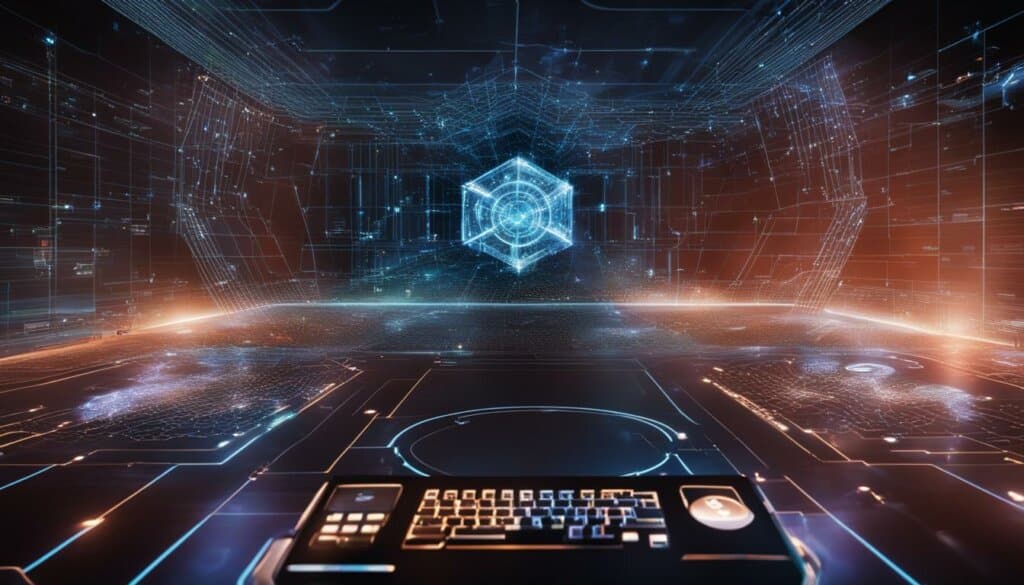Table of Contents
Organizations across industries are increasingly investing in technology to support remote work and enhance customer experiences. However, this increased reliance on technology also creates new vulnerabilities and exposes companies to potential cyber threats. The scope of cyber threats is expanding, with highly sophisticated adversaries leveraging AI and machine learning. No organisation is immune to these risks, and even the most advanced cyber controls will soon be outdated. It is crucial for leaders to assess their current cybersecurity capabilities and anticipate future threats to ensure the resilience of their technology.
In the on-demand economy, cyber protection, online security, digital privacy, and data encryption are key concerns. The growing trend of on-demand access to data brings with it a higher risk of data breaches. With organizations collecting and centralizing large volumes of data, the need for robust cybersecurity measures becomes paramount.
As hackers become more sophisticated, utilizing AI and machine learning in their attacks, organizations must continually adapt their cybersecurity defenses. Ransomware attacks and phishing attacks have surged, posing significant risks to sensitive data and operational continuity.
Regulatory compliance and privacy concerns further compound the challenges organizations face in managing their cyber risks. The evolving regulatory landscape and talent gap in cybersecurity resources necessitate a strong cybersecurity culture and proactive approach to stay ahead of potential threats.
To mitigate the risks and impact of cyber threats, organizations must build defensive capabilities. Implementing zero-trust architecture, leveraging behavioral analytics, and employing data encryption technologies are essential in securing instant access data.
Cybersecurity readiness should go beyond prevention and focus on effective incident response strategies. Regular simulation exercises and continuous improvement of response capabilities are vital in enhancing overall cybersecurity readiness.
The role of cybersecurity technology providers is crucial in developing secure solutions tailored to the on-demand economy. Cloud security, artificial intelligence, and pricing mechanisms that prioritize outcomes will be in high demand.
Cybersecurity regulations have become increasingly important as policymakers aim to protect data and manage cybersecurity risks. Organizations must comply with these regulations and focus on readiness, response, and remediation to mitigate the impact of cyberattacks.
Sectors such as financial services and healthcare are particularly vulnerable to cyber threats due to the value and sensitivity of their data. Regulatory compliance, technology investments, and employee awareness are key in bolstering cybersecurity in these sectors.
As the cyber landscape continues to evolve rapidly, organizations must remain proactive and adapt to new challenges. By building a resilient cybersecurity culture, investing in technology solutions, and staying compliant with regulations, organizations can ensure the protection of their instant access data and maintain the trust of customers and stakeholders.
The Growing Risks of On-Demand Access to Data
On-demand access to data and information platforms is on the rise, driven by mobile platforms, remote work, and other shifts. This trend increases the likelihood of a data breach, with organizations collecting and centralising large volumes of data for various purposes. The cloud plays an essential role in storing and managing these data, but it also poses security challenges. Recent high-profile attacks have exploited the expanded data access, emphasising the need for robust cybersecurity measures to protect against malicious activities.
“The increasing demand for on-demand services and instant access to data exposes organizations to new risks. As more data is collected and centralised, the potential for a data breach becomes greater. The cloud, while essential for managing and storing data, also presents security challenges. Recent attacks have demonstrated the vulnerabilities associated with expanded data access, highlighting the importance of implementing strong cybersecurity measures.”
Protecting on-demand access to data requires a multi-faceted approach that encompasses network security, information security, and secure online transactions. Organizations must prioritise the implementation of comprehensive cybersecurity frameworks that include advanced threat detection and prevention mechanisms. Network security measures, such as firewalls and secure network architecture, are essential for safeguarding data against unauthorized access and intrusion attempts.
Furthermore, information security protocols, such as encryption algorithms and access controls, must be established to ensure the confidentiality, integrity, and availability of data. Secure online transactions are vital for protecting sensitive customer and financial information from interception or compromise. Implementing secure sockets layer (SSL) or transport layer security (TLS) encryption protocols can help establish secure communication channels for online transactions.
| Security Service | Features |
|---|---|
| Network Security | Firewalls, Intrusion Detection Systems (IDS), Virtual Private Networks (VPNs) |
| Information Security | Data encryption, access controls, security awareness training |
| Secure Online Transactions | SSL/TLS encryption, two-factor authentication, secure payment gateways |
Implementing on-demand security services is crucial for organizations operating in the on-demand economy. By prioritising network security, information security, and secure online transactions, organizations can build a robust cybersecurity posture that safeguards against data breaches and malicious activities. Investing in the right security technologies and adopting best practices will help organizations adapt to the evolving threat landscape and protect their valuable data assets.
AI and Machine Learning in Sophisticated Cyber Attacks
As cyber threats continue to evolve and grow in sophistication, hackers are leveraging artificial intelligence (AI) and machine learning (ML) to enhance their attack capabilities. These advanced technologies enable hackers to automate various stages of the attack lifecycle, making it easier and faster to carry out cyber attacks. One of the prominent examples of this trend is the increase in ransomware and phishing attacks.
Ransomware attacks have become more prevalent and accessible due to the use of AI and ML. These attacks involve encrypting a victim’s data and demanding a ransom in exchange for its release. The automation provided by AI and ML allows hackers to scale their operations, targeting multiple organizations simultaneously. This has led to a surge in the number of data breaches and significant financial losses.
Phishing attacks, another common cyber threat, have also benefited from AI and ML. These attacks involve tricking individuals into revealing sensitive information, such as passwords or credit card details, by impersonating legitimate entities. AI and ML algorithms can generate highly convincing phishing emails and websites, making it challenging for users to differentiate between genuine and fraudulent communication.
“The use of AI and machine learning by hackers has significantly increased the sophistication and effectiveness of cyber attacks. Organizations must adapt their cybersecurity defenses to keep pace with these evolving threats.”
To combat the growing threat of AI and ML-enabled cyber attacks, organizations need to adopt advanced cybersecurity solutions. These solutions employ AI and ML algorithms themselves to detect and respond to suspicious activities in real time. By leveraging these technologies, organizations can proactively identify potential threats and mitigate them before they cause significant damage.

Enhancing Cybersecurity Solutions
Implementing effective cybersecurity solutions to combat AI and ML-enabled attacks requires a multi-layered approach. Organizations should focus on:
- Investing in advanced threat detection and response systems that utilize AI and ML algorithms to identify and mitigate emerging threats.
- Ensuring regular software updates and patching to protect against known vulnerabilities that hackers may exploit.
- Training employees about phishing techniques and best practices for identifying and reporting suspicious emails or websites.
- Implementing strong access controls, such as two-factor authentication and privileged access management, to limit the potential impact of a successful attack.
- Regularly conducting penetration testing and vulnerability assessments to identify weaknesses and address them proactively.
By adopting these measures and staying vigilant against evolving cyber threats, organizations can strengthen their cybersecurity defenses and protect their sensitive data from AI and ML-enabled attacks.
The Regulatory Landscape and Challenges in Cybersecurity Resources
Ensuring regulatory compliance is a critical aspect of cybersecurity for organizations operating in the on-demand economy. Regulators are increasing their scrutiny of corporate cybersecurity capabilities, and organizations must stay up-to-date with the ever-changing regulatory landscape. Failure to comply with regulations can result in hefty fines and reputational damage. However, many organizations face challenges in meeting regulatory requirements.
One of the main challenges is the constant evolution of privacy concerns. As technology advances and data becomes more valuable, individuals and governments are increasingly concerned about the privacy and security of personal information. Organizations must navigate these concerns and implement robust privacy measures to protect customer data.
Another challenge is the shortage of cybersecurity talent. The demand for cybersecurity professionals far outweighs the supply, leading to a significant talent gap. Organizations struggle to find skilled professionals who can effectively manage cyber risks and ensure the resilience of their technology. Bridging this knowledge gap is crucial to maintaining strong cybersecurity defenses.
The Regulatory Landscape and Challenges
To address these challenges, organizations need to invest in building a strong cybersecurity culture. This includes providing ongoing training and education to employees, raising awareness about the importance of cybersecurity, and fostering a culture of accountability and responsibility. Organizations should also consider partnering with external cybersecurity experts to augment their existing capabilities.
In addition, organizations must keep pace with the evolving regulatory requirements. This requires staying informed about new regulations and ensuring that processes and controls are in place to achieve and maintain compliance. It is also important to establish mechanisms for regular risk assessments and audits to identify any gaps in compliance and take appropriate remedial actions.
Overall, navigating the regulatory landscape and addressing the challenges in cybersecurity resources are crucial steps for organizations to strengthen their cybersecurity defenses. By prioritizing regulatory compliance, addressing privacy concerns, bridging the knowledge gap, and building a strong cybersecurity culture, organizations can better protect their instant access data and ensure the resilience of their technology in the on-demand economy.
| Challenges | Solutions |
|---|---|
| Constant evolution of privacy concerns | – Implement robust privacy measures – Stay informed about privacy regulations – Regularly assess and enhance privacy controls |
| Shortage of cybersecurity talent | – Invest in cybersecurity training and education – Partner with external cybersecurity experts – Foster a culture of cybersecurity awareness |
| Keeping pace with evolving regulatory requirements | – Stay informed about new regulations – Establish mechanisms for regular risk assessments and audits – Take remedial actions to achieve and maintain compliance |
Building Defensive Capabilities
As organizations rely more on on-demand access to data, the need for robust defensive cybersecurity capabilities becomes increasingly crucial. Implementing the right measures can help protect sensitive information and mitigate the risks of cyber threats. In this section, we will explore four key defensive capabilities that organizations should consider.
Zero-Trust Architecture
One effective approach to bolster cybersecurity is the implementation of a zero-trust architecture. This framework operates on the principle of granting access based on policies rather than static perimeters. It focuses on users, assets, and resources, allowing organizations to have finer control over who can access specific data and resources. By adopting a zero-trust architecture, organizations can mitigate potential risks associated with unauthorized access and lateral movement within their networks.
Behavioral Analytics
Behavioral analytics plays a crucial role in detecting and preventing cyber threats. This capability involves monitoring user behavior and device activity to identify anomalous patterns or behaviors that may indicate a potential security breach. By leveraging machine learning algorithms, organizations can establish baselines for normal behavior, enabling them to quickly identify and respond to any abnormal activities that may point to a cyber attack.
Elastic Log Monitoring
Elastic log monitoring allows organizations to monitor and analyze massive volumes of log data in real-time. This capability is essential for detecting and investigating potential security incidents, as it enables organizations to identify any unusual patterns or activities that may indicate malicious behavior. The ability to scale log monitoring capabilities elastically ensures that organizations can effectively handle and analyze the ever-increasing amount of log data generated by their systems and applications.
Homomorphic Encryption
Data encryption is a fundamental aspect of cybersecurity. Homomorphic encryption takes data protection to the next level by allowing secure access to encrypted data without the need for decryption. This capability enables organizations to perform calculations and analysis on encrypted data while preserving its confidentiality. By leveraging homomorphic encryption, organizations can ensure that sensitive data remains secure, even when it is being processed or analyzed.
Implementing defensive cybersecurity capabilities like zero-trust architecture, behavioral analytics, elastic log monitoring, and homomorphic encryption can significantly enhance an organization’s ability to protect its on-demand access data from cyber threats. By adopting these measures, organizations can strengthen their cybersecurity posture and safeguard their sensitive information.
| Defensive Cybersecurity Capabilities | Description |
|---|---|
| Zero-Trust Architecture | An approach that grants access based on policies rather than static perimeters, providing granular access control and mitigating unauthorized access risks |
| Behavioral Analytics | The monitoring of user behavior and device activity to detect anomalous patterns or behaviors that may indicate a security breach |
| Elastic Log Monitoring | The capability to monitor and analyze massive volumes of log data in real-time to detect and investigate potential security incidents |
| Homomorphic Encryption | Data encryption that allows secure access and analysis of encrypted data without decryption, preserving confidentiality |
Enhancing Cybersecurity Readiness Through Simulation
Organizations can increase their cybersecurity readiness by regularly testing their ability to detect and identify cyberattacks. Simulation exercises can help refine existing processes and identify any weaknesses or gaps. By creating realistic scenarios, organizations can assess their incident response capabilities and determine the effectiveness of their cyber defense strategies.
“Simulation exercises play a crucial role in preparing organizations for cyber threats,” says cybersecurity expert Dr. Emma Johnson. “They allow teams to practice incident response in a controlled environment, enabling them to learn from mistakes and develop efficient protocols.”
During a cyber defense simulation, organizations can evaluate their ability to detect potential threats and initiate a rapid response. This includes testing the effectiveness of monitoring systems, analyzing network traffic, and identifying indicators of compromise. By simulating different attack scenarios, organizations can also assess the readiness of their incident response teams and the coordination between different departments and external stakeholders.
Moreover, cyber defense simulations enable organizations to assess the effectiveness of their incident management processes, including communication protocols, escalation procedures, and decision-making frameworks. These exercises also provide valuable insights into the effectiveness of the organization’s crisis nerve center, enabling adjustments and improvements to enhance cyber defense capabilities.
| Benefits of Cyber Defense Simulations | Key Elements to Consider |
|---|---|
|
|
By regularly conducting cyber defense simulations, organizations can proactively enhance their cybersecurity readiness and develop effective incident response capabilities. These exercises play a vital role in preparing teams to identify and mitigate cyber threats effectively, ultimately strengthening an organization’s overall security posture.

The Role of Cybersecurity Technology Providers
Cybersecurity technology plays a crucial role in protecting organizations from cyber threats in the on-demand economy. As the demand for cloud technologies continues to grow, cybersecurity providers have the opportunity to develop secure solutions tailored to both general and specialized configurations. Cloud security is of utmost importance, as organizations rely on cloud platforms to store and manage their data.
Artificial intelligence (AI) is another key aspect of cybersecurity technology. AI can help organizations detect and respond to cyber threats more effectively by analyzing vast amounts of data and identifying patterns that indicate malicious activities. However, building trust in autonomous intelligent cyber defense platforms is essential for the successful implementation of AI in cybersecurity.
“We believe that cybersecurity technology should focus on outcomes rather than just the technology itself.”
– Cybersecurity Technology Provider
Pricing mechanisms for cybersecurity technology also play a significant role in the market. Providers need to offer competitive pricing models that cater to different organization sizes and budgets. This includes flexible pricing options that can adapt to the evolving needs of organizations, ensuring they have access to the necessary cybersecurity tools and services.
Table: Cybersecurity Technology Providers Comparison
| Provider | Cybersecurity Solutions | Cloud Security | Artificial Intelligence Integration | Pricing Mechanisms |
|---|---|---|---|---|
| Provider A | Advanced threat detection, data encryption | Secure cloud infrastructure | AI-powered threat intelligence | Flexible pricing based on usage |
| Provider B | Endpoint protection, network security | Cloud access security brokers | AI-driven threat hunting | Subscription-based model |
| Provider C | Incident response, vulnerability management | Cloud workload protection | AI-enhanced security analytics | Pricing tiers based on organization size |
Managed services are also gaining popularity in the cybersecurity market. These services offer comprehensive cybersecurity solutions that encompass various aspects of cyber defense, including threat intelligence, incident response, and vulnerability management. Managed services providers focus on outcomes rather than just the technology itself, providing organizations with the expertise and support they need to strengthen their cybersecurity defenses.
Overall, cybersecurity technology providers have a significant role to play in helping organizations protect their instant access data in the on-demand economy. By offering secure solutions, integrating artificial intelligence, providing flexible pricing mechanisms, and delivering comprehensive managed services, these providers can empower organizations to defend against evolving cyber threats.

The Implications of Cybersecurity Regulations
As cyber threats continue to escalate, governments and regulatory bodies around the world are introducing stringent cybersecurity regulations to protect data and manage the associated risks. Compliance with these regulations is not only essential for legal and ethical reasons but also crucial for maintaining the trust of customers and stakeholders.
One key aspect of cybersecurity regulations is cybercrime reporting. Organizations are required to promptly report any cyber incidents or breaches they experience to the appropriate authorities. This enables regulatory bodies to assess the extent of the breach and take necessary actions to mitigate its impact. By mandating cybercrime reporting, regulators aim to create a transparent and accountable environment, fostering collaboration between organizations and authorities in combating cyber threats.
Another critical implication of cybersecurity regulations is the need for crisis response plans. Organizations must develop comprehensive plans that outline the steps to be taken in the event of a cyberattack or data breach. These plans should cover aspects such as incident response, communication strategies, and coordination with law enforcement agencies. By having robust crisis response plans in place, organizations can minimize the damage caused by cyber incidents and ensure a swift and effective recovery process.
Table: Key Components of Cybersecurity Regulations
| Regulatory Requirement | Description |
|---|---|
| Cybercrime Reporting | Mandatory reporting of cyber incidents and breaches to authorities. |
| Crisis Response Plans | Development of comprehensive plans for addressing cyber incidents. |
| Data Privacy Protection | Ensuring the security and confidentiality of personal and sensitive data. |
| Third-Party Risk Management | Evaluation and mitigation of cyber risks associated with third-party vendors. |
| Employee Training and Awareness | Regular training programs to educate employees about cyber threats and best practices. |
Cybersecurity regulations also address data privacy protection. Organizations are required to implement measures to ensure the security and confidentiality of personal and sensitive data. This includes mechanisms such as data encryption, access controls, and regular security audits. By safeguarding data privacy, organizations can protect their customers’ trust and comply with regulatory requirements.
Lastly, cybersecurity regulations emphasize the importance of third-party risk management. Organizations must assess the cyber risks associated with their third-party vendors and ensure that appropriate security measures are in place. This involves conducting due diligence during vendor selection, establishing contractual obligations for cybersecurity, and regularly monitoring vendor compliance. By effectively managing third-party risks, organizations can mitigate the potential vulnerabilities introduced through their supply chain.
In conclusion, cybersecurity regulations have significant implications for organizations operating in the on-demand economy. By complying with these regulations, organizations can demonstrate their commitment to protecting data, respond effectively to cyber incidents, and maintain the trust of their stakeholders. It is imperative for businesses to stay updated on the evolving regulatory landscape and adapt their cybersecurity strategies accordingly to effectively manage the ever-increasing cyber risks.

Cybersecurity in Different Sectors: Financial Services and Healthcare
The financial services sector and healthcare industry are two sectors that face significant cybersecurity challenges due to the high-value assets and sensitive data they handle. In an era of digital transformation, where technology plays a crucial role in providing efficient services and improving patient care, data protection becomes paramount.
In the financial sector, where digital banking and online transactions are the norm, cybersecurity is crucial to protect customer data, prevent fraud, and maintain trust in the digital payments ecosystem. Financial institutions must implement robust cybersecurity measures to safeguard sensitive financial information, including personal and payment data. The risk of cyberattacks, such as data breaches and financial fraud, necessitates continuous monitoring, threat detection, and response strategies.
The healthcare sector is also increasingly vulnerable to cyber threats. The digitization of medical records and the proliferation of Internet of Things (IoT) devices create new entry points for cybercriminals. Protecting patient data and ensuring the integrity of medical devices are critical for maintaining patient privacy and delivering quality care. Healthcare organizations must invest in cybersecurity solutions that not only protect sensitive data but also mitigate the risks associated with ransomware attacks, unauthorized access to medical devices, and data breaches.
In an era of digital transformation, where technology plays a crucial role in providing efficient services and improving patient care, data protection becomes paramount.
Both sectors must prioritize cybersecurity by implementing comprehensive security frameworks, conducting regular risk assessments, and fostering a cybersecurity culture among employees. Collaboration between industry stakeholders, governments, and regulatory bodies is essential to develop robust cybersecurity protocols and best practices that address sector-specific challenges.
| Financial Services | Healthcare | |
|---|---|---|
| Data Protection | Secure customer financial data, prevent fraud | Protect patient data, ensure privacy |
| Digital Transformation | Digital banking, online transactions | Digitization of medical records, IoT devices |
| Cyber Threats | Data breaches, financial fraud | Ransomware attacks, unauthorized device access |
The convergence of cybersecurity and technology advancements is crucial for securing these sectors against evolving cyber threats. Robust cybersecurity measures, regular vulnerability assessments, and employee training programs can help fortify the financial services and healthcare sectors, ensuring data protection and maintaining the trust of customers and patients alike.
Conclusion
The cybersecurity landscape is constantly evolving, bringing new challenges and risks for organizations to address. To effectively protect their instant access data in the on-demand economy, organizations must stay proactive and keep up with cybersecurity trends. By anticipating future threats and enhancing defensive capabilities, organizations can effectively manage cyber risk and safeguard their technology.
Building a resilient cybersecurity culture is essential for organizations to withstand potential cyber threats. It is crucial to invest in technology solutions that can keep pace with the evolving cyber landscape and provide robust protection against malicious activities. Additionally, organizations must remain compliant with regulations to ensure the integrity and security of their data.
As cybersecurity continues to be a top priority, organizations in all sectors should focus on implementing resilient technology and cyber risk management practices. By doing so, they can future-proof their cybersecurity defenses and maintain the trust of customers and stakeholders. Remember, cybersecurity is an ongoing effort that requires constant attention and adaptation to address new and emerging threats.
FAQ
What is the importance of cybersecurity in the on-demand economy?
Cybersecurity is crucial in the on-demand economy to protect instant access data, ensure online security, and maintain digital privacy. It helps prevent data breaches, protect against cyber threats, and safeguard sensitive information.
What are the risks associated with on-demand access to data?
On-demand access to data increases the likelihood of a data breach and exposes organizations to potential cyber threats. Organizations collect and centralize large volumes of data, which can be targeted by hackers. The cloud storage, although convenient, also poses security challenges.
How do AI and machine learning impact cyber attacks?
Sophisticated cyber attackers leverage AI and machine learning to expedite the entire attack life cycle. They use these technologies to launch ransomware attacks, phishing attacks, and other malicious activities. This increases the need for organizations to continuously adapt their cybersecurity defenses.
What are the challenges organizations face in cybersecurity resources?
Many organizations lack the necessary talent, knowledge, and expertise to effectively manage cyber risks. The growing compliance requirements and privacy concerns further exacerbate the talent gap. Organizations must invest in building a strong cybersecurity culture while keeping up with regulatory requirements.
What defensive capabilities can organizations develop for cybersecurity?
Organizations can develop defensive capabilities such as zero-trust architecture, behavioral analytics, elastic log monitoring, and homomorphic encryption. These capabilities focus on enhancing access control, monitoring user behavior, and securing large data sets.
How can organizations enhance their cybersecurity readiness through simulation?
Regularly testing the ability to detect and identify cyberattacks through simulation exercises helps refine existing processes and identify weaknesses. Organizations can improve incident response capabilities by establishing crisis nerve centers and implementing protocols for alternative support and services during an attack.
What is the role of cybersecurity technology providers?
Cybersecurity technology providers play a crucial role in developing secure solutions tailored to different configurations. They should focus on enhancing cloud security, building trust in autonomous intelligent cyber defense platforms, and offering comprehensive cybersecurity solutions that prioritize outcomes.
How do cybersecurity regulations impact organizations?
Cybersecurity regulations are continually evolving, and organizations must stay informed to comply with them. Organizations need processes in place to detect, report, and respond to cybercrime incidents. Readiness, response, and remediation are crucial aspects to effectively mitigate the impact of cyberattacks.
How does cybersecurity apply to the financial services and healthcare sectors?
The financial services sector requires cybersecurity to protect customer data, prevent fraud, and maintain trust in the digital payments ecosystem. In the healthcare sector, digitization and IoT devices increase the risk of cyberattacks. Regulatory compliance, technology investments, and employee awareness are essential for enhancing cybersecurity in these sectors.
How can organizations future-proof their cybersecurity defenses?
By staying proactive and anticipating trends, organizations can enhance their defensive capabilities. Building a resilient cybersecurity culture, investing in technology solutions, and staying compliant with regulations are crucial steps to future-proof cybersecurity defenses and safeguard data.
Source Links
- https://www.mckinsey.com/featured-insights/mckinsey-explainers/what-is-cybersecurity
- https://www.ncbi.nlm.nih.gov/pmc/articles/PMC10422504/
- https://www.mckinsey.com/capabilities/risk-and-resilience/our-insights/cybersecurity/cybersecurity-trends-looking-over-the-horizon













